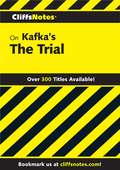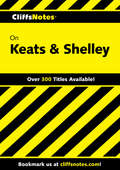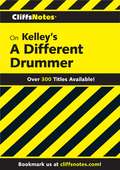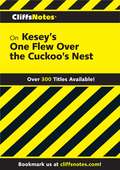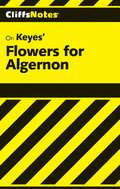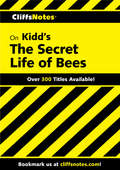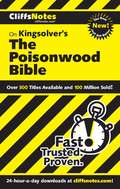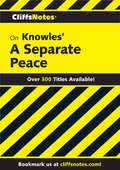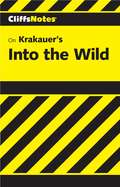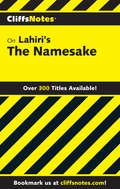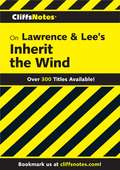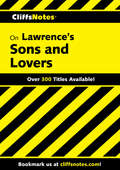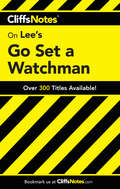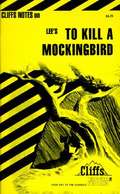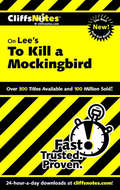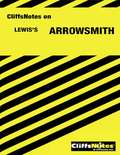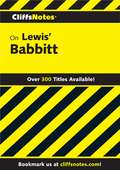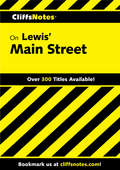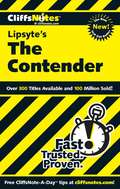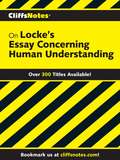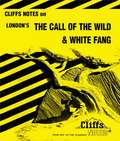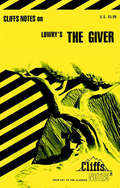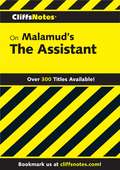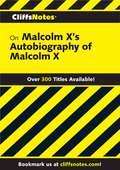- Table View
- List View
CliffsNotes on Kafka's The Trial (Cliffsnotes Ser.)
by Herberth CzermakThis CliffsNotes guide includes everything you’ve come to expect from the trusted experts at CliffsNotes, including analysis of the most widely read literary works.
CliffsNotes on Keats & Shelley
by Dougald B MaceachenThis CliffsNotes guide includes everything you’ve come to expect from the trusted experts at CliffsNotes, including analysis of the most widely read literary works.
CliffsNotes on Kelley's A Different Drummer
by Nathan GarnerThis CliffsNotes guide includes everything you've come to expect from the trusted experts at CliffsNotes, including analysis of the most widely read literary works.
CliffsNotes on Kesey's One Flew Over the Cuckoo's Nest
by Bruce E WalkerThe original CliffsNotes study guides offer expert commentary on major themes, plots, characters, literary devices, and historical background. The latest generation of titles in this series also feature glossaries and visual elements that complement the classic, familiar format.In CliffsNotes on One Flew Over the Cuckoo's Nest, you explore Ken Kesey's best-known work, one that challenges the preconceived ideas of what constitutes sanity and insanity. A mistakenly undertaken power struggle in an insane asylum results in a suicide, a murder, and a liberation, and leaves the reader with a paradoxical feeling that both disturbs and pleases.This study guide carefully walks you through the novel by providing summaries and critical analyses of each section. You'll also explore the life and background of the author, Ken Kesey, and gain insight into how he came to write One Flew Over the Cuckoo's Nest. Other features that help you study includeCharacter analyses of major playersA character map that graphically illustrates the relationships among the charactersCritical essays on topics like the role of women and the comparison between the film and novelA review section that tests your knowledgeA Resource Center full of books, articles, films, and Internet sitesClassic literature or modern-day treasure—you'll understand it all with expert information and insight from CliffsNotes study guides.
CliffsNotes on Keyes' Flowers For Algernon
by Janet ClarkFlowers For Algernon made its first appearance as a short story which was rapidly and widely anthologized, and translated internationally. It received further acclaim as a moderated television drama, and as a motional picture production. Now, full bodied and richly-peopled, Flowers For Algernon is the daring novel of a starling human experiment!
CliffsNotes on Kidd's The Secret Life of Bees
by Susan Van KirkThe original CliffsNotes study guides offer expert commentary on major themes, plots, characters, literary devices, and historical background. In CliffsNotes on Kidd's The Secret Life of Bees, you explore the rural South in the Civil Rights era of the 1960s, where a young girl named Lily Owens is growing up unwanted and unloved. Escaping her home, she begins a journey of self-discovery and learns about racial prejudice. Taken in by a community of strong African-American sisters, she gains strength, knowledge, and self-forgiveness before finally confronting the injustice of the law and the wrath of her callous father. This study guide, which carefully walks you through Lily's learning to love herself living within a community of strong, independent women and to trust her own instincts and mature into a young lady who believes in herself, provides summaries and critical analyses of each chapter of the novel. You'll also explore the life and background of the author, Sue Monk Kidd. Other features that help you study includeAn overview of the novelA list of characters, including analyses of major charactersA character map that graphically illustrates the relationships among the charactersAnalyses of major themes and symbolsA glossary of important terms and phrases from the novelClassic literature or modern-day treasure--you'll understand it all with expert information and insight from CliffsNotes study guides.
CliffsNotes on Kingsolver's The Poisonwood Bible
by Kris FulkersonThe original CliffsNotes study guides offer expert commentary on major themes, plots, characters, literary devices, and historical background. In CliffsNotes on Kingsolver's The Poisonwood Bible, you explore life in 20th-century Congo as you follow the ordeal of missionary Nathan Price and his family, who are woefully unprepared to deal with life in such a drastically different culture and climate. Nathan is inflexible in his approach to both the Congolese and his family, and his wife and daughters are overwhelmed by their changed circumstances. The story of this family's struggle against the backdrop of the Congolese independence movement makes The Poisonwood Bible Kingsolver's most powerful novel yet. This study guide carefully walks you through every step of the Price family's journey by providing summaries and critical analyses of each book of the novel. You'll also explore the life and background of the author, Barbara Kingsolver. Other features that help you study includeAn overview of the novelA character map that graphically illustrates the relationships among the charactersA glossary of important terms and phrases from the novelClassic literature or modern-day treasure—you'll understand it all with expert information and insight from CliffsNotes study guides.
CliffsNotes on Knowles' A Separate Peace
by Regina Higgins Charles Higgins Cary M. RobertsThe original CliffsNotes study guides offer expert commentary on major themes, plots, characters, literary devices, and historical background. The latest generation of titles in this series also feature glossaries and visual elements that complement the classic, familiar format.In CliffsNotes on Knowles' A Separate Peace, you explore John Knowles greatest work, which is one of the most popular post-war novels about adolescence. Here, you meet Gene, who faces the challenge of finding his own individuality in a conformist world—the kind of individuality he's envious of in his friend, the free-spirited Finny.This study guide carefully walks you through every step of Gene's journey by providing summaries and critical analyses of each chapter of the novel. You'll also explore the life and background of the author, John Knowles, and gain insight into how he came to write A Separate Peace. Other features that help you study includeCharacter analyses of major playersA character map that graphically illustrates the relationships among the charactersCritical essays on innocence and the uneasy friendship between Gene and FinnyA review section that tests your knowledgeA Resource Center full of books, articles, films, and Internet sitesClassic literature or modern-day treasure—you'll understand it all with expert information and insight from CliffsNotes study guides.
CliffsNotes on Krakauer's Into the Wild
by Adam SextonThe CliffsNotes study guide on Krakauer's Into the Wild supplements the original literary work, giving you background information about the author, an introduction to the work, a graphical character map, critical commentaries, expanded glossaries, and a comprehensive index, all for you to use as an educational tool that will allow you to better understand the work. This study guide was written with the assumption that you have read Into the Wild. Reading a literary work doesn't mean that you immediately grasp the major themes and devices used by the author; this study guide will help supplement your reading to be sure you get all you can from Krakauer's Into the Wild. CliffsNotes Review tests your comprehension of the original text and reinforces learning with questions and answers, practice projects, and more. For further information on Krakauer's Into the Wild, check out the CliffsNotes Resource Center at www.cliffsnotes.com.
CliffsNotes on Lahiri's The Namesake
by Gregory ColesCliffsNotes on Jhumpa Lahiri's The Namesake includes summaries and analyses of this best-selling novel about a family's struggles to assilmilate into American culture.
CliffsNotes on Lawrence & Lee's Inherit the Wind
by Suzanne PavlosThe original CliffsNotes study guides offer expert commentary on major themes, plots, characters, literary devices, and historical background. The latest generation of titles in this series also feature glossaries and visual elements that complement the classic, familiar format.CliffsNotes on Inherit the Wind is an illuminating guide to the Jerome Lawrence and Robert E. Lee play about the evolution-versus-creationism debate. Chapter summaries and expert analysis provide insight into the central conflict between fundamentalist Matthew Harrison Brady and gifted orator Henry Drummond. The townspeople in this play also dramatize what freedom of thought -- as well as "the right to be wrong" -- truly mean. Other features that help you study includeCharacter analyses of major playersA character map that graphically illustrates the relationships among the charactersCritical essays on the play's themes, conflicts, and moreA review section that tests your knowledgeBackground information on the playwrights and their partnershipClassic literature or modern modern-day treasure — you'll understand it all with expert information and insight from CliffsNotes study guides.
CliffsNotes on Lawrence's Sons and Lovers
by Rita Granger ShawThis CliffsNotes guide includes everything you’ve come to expect from the trusted experts at CliffsNotes, including analysis of the most widely read literary works.
CliffsNotes on Lee's Go Set a Watchman
by Gregory ColesCliffsNotes on Harper Lee's Go Set a Watchman, authored before but sensationally published well after Lee's To Kill a Mockingbird, includes everything you've come to expect from the trusted experts at CliffsNotes, including summaries and analyses of Lee's novel. Features of this Lit Note includeFocused summaries of the plot and analysis of important themes, symbols, and character developmentCharacter analyses of major characters, focusing on what motivates each characterBrief synopsis of the novelShort quiz
CliffsNotes on Lee's To Kill A Mockingbird
by Dawn B. Sova Eva FitzwaterExplores themes, character development, and recurring images, along with in-depth character analysis. A coming-of-age story set in the South, this novel is rich with subjects for conversation. "To Kill a Mockingbird" is narrated by Scout, a young girl on the brink of a life-changing event, the novel received the Pulitzer Prize in 1960.
CliffsNotes on Lee's To Kill a Mockingbird
by Tamara CastlemanThe original CliffsNotes study guides offer expert commentary on major themes, plots, characters, literary devices, and historical background. The latest generation of titles in this series also feature glossaries and visual elements that complement the classic, familiar format.In CliffsNotes on To Kill a Mockingbird, you explore Harper Lee's literary masterpiece -- a novel that deals with Civil Rights and racial bigotry in the segregated southern United States of the 1930s. Told through the eyes of the memorable Scout Finch, the novel tells the story of her father, Atticus, as he hopelessly strives to prove the innocence of a black man accused of raping and beating a white woman.Chapter summaries and commentaries take you through Scout's coming of age journey. Critical essays give you insight into racial relations in the South during the 1930s, as well as a comparison between the novel and its landmark film version. Other features that help you study includeCharacter analyses of the main charactersA character map that graphically illustrates the relationships among the charactersA section on the life and background of Harper LeeA review section that tests your knowledgeA Resource Center full of books, articles, films, and Internet sitesClassic literature or modern modern-day treasure -- you'll understand it all with expert information and insight from CliffsNotes study guides.
CliffsNotes on Lewis' Arrowsmith
by Salibelle RoysterThe Pulitzer Prize winning Arrowsmith (an award Lewis refused to accept) recounts the story of a doctor who is forced to give up his trade for reasons ranging from public ignorance to the publicity-mindedness of a great foundation, and becomes an isolated seeker of scientific truth.
CliffsNotes on Lewis' Babbitt
by Sinclair LewisThis CliffsNotes guide includes everything you've come to expect from the trusted experts at CliffsNotes, including analysis of the most widely read literary works.
CliffsNotes on Lewis' Main Street
by Salibelle RoysterThis classic by Sinclair Lewis shattered the sentimental American myth of happy small-town life with its satire. Main Street attacks the conformity and dullness of early 20th Century midwestern village life in the story of Carol Milford, the city girl who marries the town doctor. Her efforts to bring culture to the prairie village are met by a wall of gossip, greed, and petty small-minded bigotry. Lewis's complex and compelling work established him as an important character in American literature.
CliffsNotes on Lipsyte's The Contender
by Stanley P BaldwinThe original CliffsNotes study guides offer a look into critical elements and ideas within classic works of literature.In CliffsNotes on The Contender, you look into a moral tale that emphasizes the importance of the fight over the prize, the quality of the struggle over the outcome.Following the development of the novel's protagonist, this study guide's in-depth character analysis covers the coming-of-age of a high school dropout who literally fights young boxers and figuratively braves the inner battles of peer pressure. Other features that help you figure out this important work includeLife and background of the author, Robert LipsyteIntroduction to the book with a synopsis, character list, and character mapSummaries, critical commentaries, and glossaries for each chapterCritical essays focusing on setting, major themes, and the author's writing styleA review section that tests your knowledge and suggests essay topicsA Resource Center full of books, publications, films, and Internet resourcesClassic literature or modern-day treasure -- you'll understand it all with expert information and insight from CliffsNotes study guides.
CliffsNotes on Locke's Concerning Human Understanding
by Charles H. PattersonThis CliffsNotes guide includes everything you've come to expect from the trusted experts at CliffsNotes, including analysis of the most widely read literary works.
CliffsNotes on London's The Call of the Wild & White Fang
by Samuel J UmlandThe original CliffsNotes study guides offer expert commentary on major themes, plots, characters, literary devices, and historical background.CliffsNotes on Call of the Wild & White Fang covers not one, but two of Jack London's best known adventures. Meet an amazing dog named Buck and his human friend John Thornton in Call of the Wild, and then follow the story of two men, Henry and Bill, and the life of an unforgettable wolf cub.This study guide will help you keep up with all of the action as you contemplate the characters and their motivations. Helpful background information about the author brings these novels into context for even greater understanding. Other features that help you study includeComplete character listsCharacter analyses of major playersCritical essaysReview questionsClassic literature or modern modern-day treasure -- you'll understand it all with expert information and insight from CliffsNotes study guides.
CliffsNotes on Lowry's The Giver
by Suzanne PavlosThe original CliffsNotes study guides offer a look into key elements and ideas within classic works of literature.CliffsNotes on The Giver explores a world in which disease, hunger, poverty, war, and lasting pain simply don't exist. The members of this utopia have given up all human emotions and memories to live in a state of Sameness.Following the story of a 12-year-old boy who recognizes the hypocrisy of his community's "social order" - and who crafts a way to free everyone from the bane of Sameness, this study guide provides summaries and critical commentaries for each chapter within the novel. Other features that help you figure out this important work includePersonal background on the author, Lois LowryIntroduction to and synopsis of the bookCharacter descriptionsCritical essays on the author's themes, style, language, and moreReview section that features interactive questions and suggested essay topicsSelected bibliography and list of critical worksClassic literature or modern-day treasure -- you'll understand it all with expert information and insight from CliffsNotes study guides.
CliffsNotes on Machiavelli's The Prince
by Stacy MagedanzThe original CliffsNotes study guides offer expert commentary on major themes, plots, characters, literary devices, and historical background. The latest generation of titles in this series also feature glossaries and visual elements that complement the classic, familiar format.In CliffsNotes on The Prince, you explore the Italian Renaissance in Florence in the late 1400s and early 1500s, during which Machiavelli was a statesman who took a special interest in observing the distinct intelligence that made certain rulers successful. In a nutshell, The Prince is an analysis of how to acquire and maintain political power. It remains one of the definitive statements of power and control and is based on what Machiavelli saw, not what he felt or imagined.This study guide carefully walks you through The Prince by providing summaries and critical analyses of each chapter of the book. You'll also explore the life and background of the author. Other features that help you study includeA list of people the book exploresGlossaries in each chapter to define new termsCritical essays about topics like the vilification of Machiavelli and free willA review section that tests your knowledgeA ResourceCenter with books, magazine articles, and Web sites for more studyClassic literature or modern modern-day treasure -- you'll understand it all with expert information and insight from CliffsNotes study guides.
CliffsNotes on Malamud's The Assistant
by Mordecai MarcusThis CliffsNotes guide includes everything you've come to expect from the trusted experts at CliffsNotes, including analysis of the most widely read literary works.
CliffsNotes on Malcolm X's The Autobiography of Malcolm X
by Ray ShepardThis is the story of a man who lived several distinct chapters of a great American life. From petty criminal to defiant race rights fighter to leader of the Black Muslim movement, his life story is provocative and engrossing.
